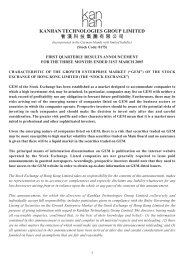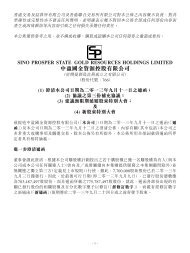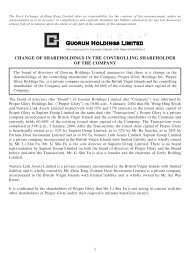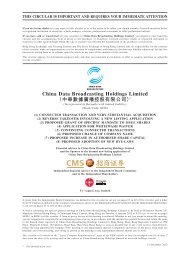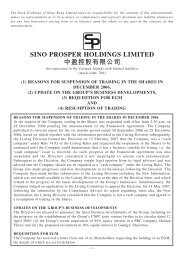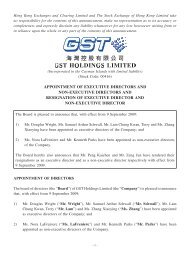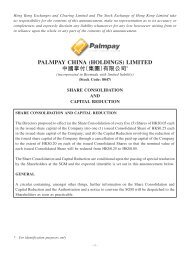0175 Geely Automobile Holdings Limited Annual Report 2011
0175 Geely Automobile Holdings Limited Annual Report 2011
0175 Geely Automobile Holdings Limited Annual Report 2011
Create successful ePaper yourself
Turn your PDF publications into a flip-book with our unique Google optimized e-Paper software.
<strong>Annual</strong> <strong>Report</strong> <strong>2011</strong><strong>Geely</strong> <strong>Automobile</strong> <strong>Holdings</strong> <strong>Limited</strong>NOTES TO THE CONSOLIDATEDFINANCIAL STATEMENTSFor the year ended 31 December <strong>2011</strong>5. Significant Accounting Policies (Continued)(f)Foreign currencies (Continued)Exchange differences arising on the settlement of monetary items, and on the translation of monetaryitems, are recognised in the consolidated income statement in the period in which they arise, except forexchange differences arising on a monetary item that forms part of the Company’s net investment in aforeign operation, in which case such exchange differences are recognised in other comprehensive income.Exchange differences arising on the retranslation of non-monetary items carried at fair value are includedin the consolidated income statement for the period except for differences arising on the retranslation ofnon-monetary items in respect of which gains and losses are recognised directly in other comprehensiveincome, in which cases, the exchange differences are also recognised directly in other comprehensiveincome.For the purposes of presenting the consolidated financial statements, the assets and liabilities of theGroup’s foreign operations are translated into the presentation currency of the Company (i.e. Renminbi) atthe rate of exchange prevailing at the balance sheet date, and their income and expenses are translatedat the average exchange rates for the year, unless exchange rates fluctuate significantly during the period,in which case, the exchange rates prevailing at the dates of transactions are used. Exchange differencesarising, if any, are recognised in other comprehensive income and accumulated in a separate componentof equity (the translation reserve). Such exchange differences are reclassified from equity to profit or lossas a reclassification adjustment in the period in which the foreign operation is disposed of.(g)Financial instrumentsFinancial assets and financial liabilities are recognised on the consolidated balance sheet when a groupentity becomes a party to the contractual provisions of the instrument. Financial assets and financialliabilities are initially measured at fair value. Transaction costs that are directly attributable to the acquisitionor issue of financial assets and financial liabilities (other than financial assets and financial liabilities at fairvalue through profit or loss) are added to or deducted from the fair value of the financial assets or financialliabilities, as appropriate, on initial recognition. Transaction costs directly attributable to the acquisition offinancial assets or financial liabilities at fair value through profit or loss are recognised immediately in theconsolidated income statement.Loans and receivablesLoans and receivables are non-derivative financial assets with fixed or determinable payments that arenot quoted in an active market. Loans and receivables (including trade and other receivables) are initiallyrecognised at fair value, and are subsequently measured at amortised cost using the effective interestmethod less any identified impairment losses. An impairment loss is recognised in the consolidated incomestatement when there is objective evidence that the asset is impaired, and is measured as the differencebetween the asset’s carrying amount and the present value of the estimated future cash flows discountedat the original effective interest rate.Objective evidence of impairment of individual financial assets includes observable data that comes to theattention of the Group about one or more of the following loss events:– Significant financial difficulty of the debtor;– A breach of contract, such as a default or delinquency in interest or principal payments;– It becoming probable that the debtor will enter bankruptcy or other financial reorganisation; and– Significant changes in the technological, market, economic or legal environment that have an adverseeffect on the debtor.70



